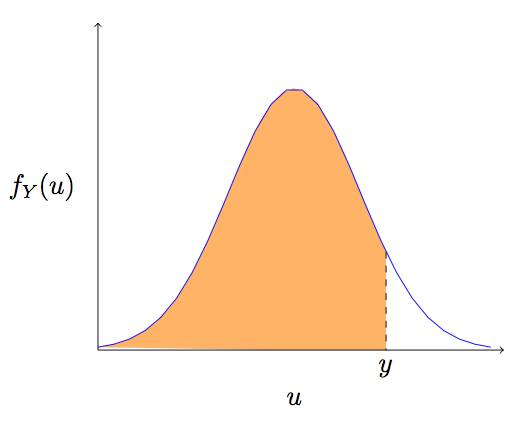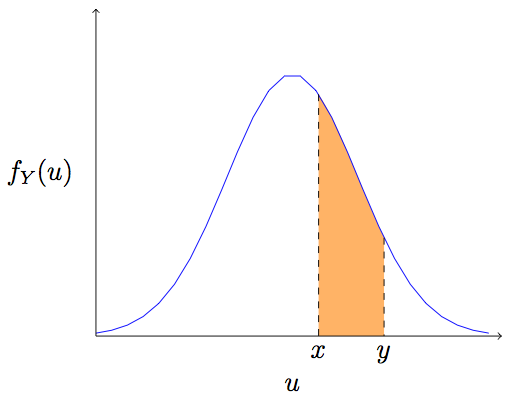I have been dabbling with the TikZ package to create some diagrams relevant to a first year microeconomics course. The following diagram of the probability density function (pdf) of a normal distribution may be useful to others wishing to integrate similar diagrams into their LaTeX documents or Beamer presentations. To use, insert the following code anywhere you like within a .tex document (you must include \usepackage{tikz} in your header):
The Cumulative Density of 

INSERT INTO .TEX DOCUMENT
\begin{tikzpicture}
% define normal distribution function 'normaltwo'
\def\normaltwo{\x,{4*1/exp(((\x-3)^2)/2)}}
% input y parameter
\def\y{4.4}
% this line calculates f(y)
\def\fy{4*1/exp(((\y-3)^2)/2)}
% Shade orange area underneath curve.
\fill [fill=orange!60] (2.6,0) -- plot[domain=0:4.4] (\normaltwo) -- ({\y},0) -- cycle;
% Draw and label normal distribution function
\draw[color=blue,domain=0:6] plot (\normaltwo) node[right] {};
% Add dashed line dropping down from normal.
\draw[dashed] ({\y},{\fy}) -- ({\y},0) node[below] {$y$};
% Optional: Add axis labels
\draw (-.2,2.5) node[left] {$f_Y(u)$};
\draw (3,-.5) node[below] {$u$};
% Optional: Add axes
\draw[->] (0,0) -- (6.2,0) node[right] {};
\draw[->] (0,0) -- (0,5) node[above] {};
\end{tikzpicture}
The Probability of  Falling Between
Falling Between  and
and 

INSERT INTO .TEX DOCUMENT
\begin{tikzpicture}
% define normal distribution function 'normaltwo'
\def\normaltwo{\x,{4*1/exp(((\x-3)^2)/2)}}
% input x and y parameters
\def\y{4.4}
\def\x{3.4}
% this line calculates f(y)
\def\fy{4*1/exp(((\y-3)^2)/2)}
\def\fx{4*1/exp(((\x-3)^2)/2)}
% Shade orange area underneath curve.
\fill [fill=orange!60] ({\x},0) -- plot[domain={\x}:{\y}] (\normaltwo) -- ({\y},0) -- cycle;
% Draw and label normal distribution function
\draw[color=blue,domain=0:6] plot (\normaltwo) node[right] {};
% Add dashed line dropping down from normal.
\draw[dashed] ({\y},{\fy}) -- ({\y},0) node[below] {$y$};
\draw[dashed] ({\x},{\fx}) -- ({\x},0) node[below] {$x$};
% Optional: Add axis labels
\draw (-.2,2.5) node[left] {$f_Y(u)$};
\draw (3,-.5) node[below] {$u$};
% Optional: Add axes
\draw[->] (0,0) -- (6.2,0) node[right] {};
\draw[->] (0,0) -- (0,5) node[above] {};
\end{tikzpicture}
The TikZ code snippet above is meant to be dropped into a .tex document and work without any further “tinkering”. Please let me know if this is not the case!



